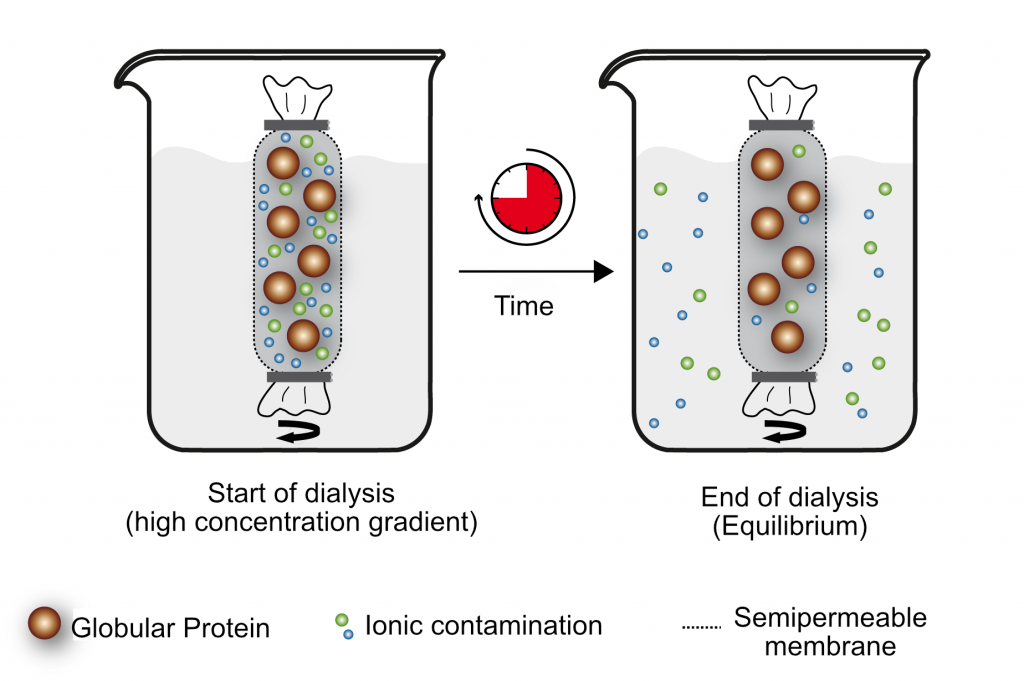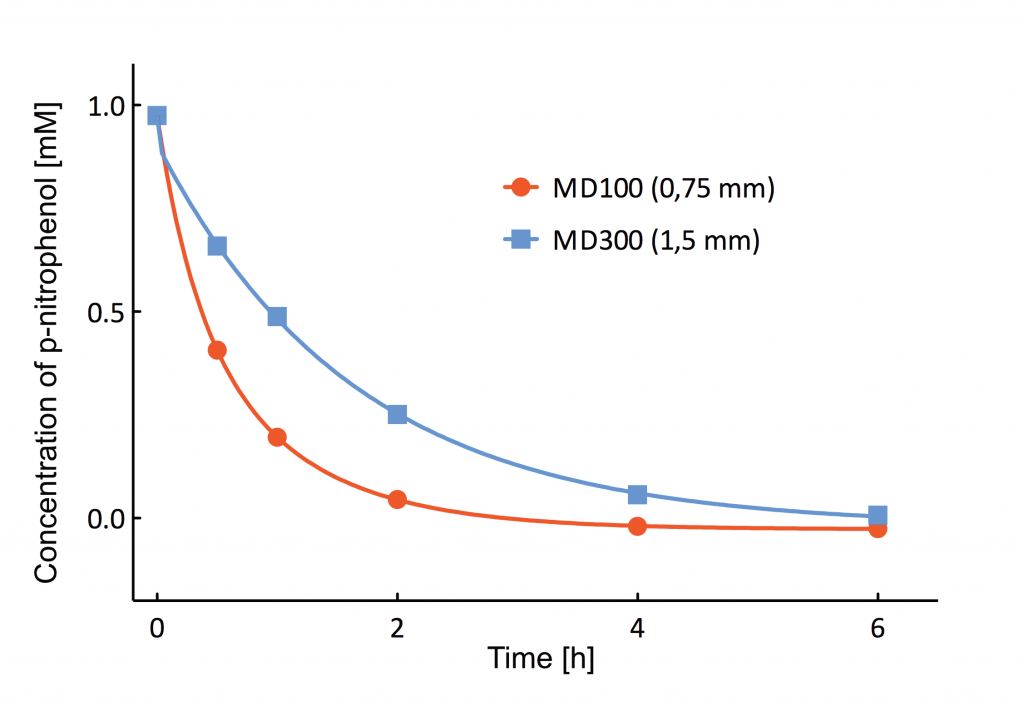Dialysis: How it works, dependencies and applications
Dialysis is a diffusion-based size-selective transport of molecules or other particles through a semipermeable membrane from a high to a lower concentration. The selectivity of dialysis is determined by the pore size of the semipermeable membrane. Dialysis is ideally suited for the separation of larger molecules (e.g. proteins) and significantly smaller molecules (e.g. salts).

Figure 1: Principle of sample dialysis
Figure 1 shows an example of the dialysis process in a dialysis tube. After purification with FPLC (fast protein liquid chromatography), a protein solution contains a high concentration of NaCl, which is interfering in subsequent process steps. The protein sample is pipetted into the dialysis tube and introduced into a large volume of dialysis buffer (water). Both protein and NaCl are present in the sample in a significantly higher concentration than the dialysis buffer and are in contact via the membrane. This diffusion-driven process is relatively slow compared to other separation processes. This prevents rapid changes in concentration and concentration saturations, which can lead to precipitation of the proteins in the sample. For renaturation and refolding experiments of proteins and to maintain protein activity, the slow change of the experimental conditions is usually advantageous. Furthermore, the clogging of the membrane pores is significantly lower compared to ultracentrifugation and only minor volume changes occur compared to gel filtration. This makes dialysis a gentle, low-loss method for separating molecules based on their size.
The advantage of slow diffusion is also a disadvantage. The process times are relatively long. Furthermore, the handling of classical dialysis tubes is complex and only suitable for a few samples, but a special laboratory equipment is not necessary. However, dialyzers that are easy to use and suitable for large numbers of samples are available on the market today. This also includes the Xpress dialyzers of the company scienova.
Diffusion is a result of the temperature-dependent random Brownian motion. This leads to the adjustment of concentration gradients to equilibrium. The flow of molecules and particles is described in Ficks first law:

J: Diffusion flow
D: Diffusion coefficient
c: concentration
x: Diffusion length
Important factors influencing dialysis are:
Concentration
The dialysis rate depends on the concentration gradient that is highest at the beginning of dialysis. During dialysis, the concentration gradient between the sample and the dialysis buffer decreases. In order to maintain a high dialysis rate, it is recommended to use a large sample to buffer volume ratio. For example, the scienova Xpress Magnetic Mixing Dialysis Box offers a larger buffer volume compared to the Deep Well plate. The second option is to exchange the buffer regularly in order to keep the concentration gradient large. A recommendation would be the buffer exchange every 30 to 60 minutes when desalinating with the scienova Xpress Micro Dialyzers.
Temperature
The dialysis rate is higher at higher temperatures. However, the tolerance of the samples to higher temperatures in most cases limits their use beyond room temperature. Particularly sensitive samples should therefore be dialyzed at 4 °C in order to avoid loss of denaturation or activity of the samples. It should be ensured that the sample and buffer do not freeze and that the dialysis rate is slowed down.
Dialysis time
The dialysis rate is influenced by numerous factors: substances, concentration, membrane, diffusion path or temperature. Many manufacturers provide application examples that can be used as a basis for optimizing dialysis conditions. The performance of pre-tests is recommended in order to find an optimal protocol.
Membrane
The flow through the membrane depends on the active membrane area, the ratio of the active membrane area to the sample volume, the pore size and porosity. This increases the dialysis rate with a larger ratio of membrane area to sample volume, higher porosity and further pores.
Another important aspect is that non-specific substances can bind to the membrane, which can lead to sample loss. Cellulose-based dialysis membranes are known to be a low-binding material, but should be tested if sample losses occur.
Diffusion path
The dialysis time increases exponentially with the diffusion path. Therefore, a dialysis device with short diffusion distances should be chosen. For example, the scienova Xpress dialyzers have a specially developed geometry that guarantees high dialysis speeds. Shaking or stirring the solutions increases the transport of the compounds.

Figure 2: Comparision of dialysis rates at different diffusion paths: The concentration decrease of the dye p-nitrophenol in micro dialyzers is shown. Scienova Xpress Micro Dialyzer MD100 (0.75 mm diffusion length)and MD300 (1.5 mm diffusion length), sample: 1 mM p-nitrophenol, dialysis buffer: 1-fold PBS pH 7.4, dialysis duration: 30 minutes, absorption measured at 420 nm (Tecan Sunrise Photometer)
Dialysis buffer
The dialysis buffer is in contact with the dialysis sample and small connections of the buffer can pass through the dialysis membrane. The selected dialysis buffer should be compatible with the planned cleaning steps and can be used to stabilize the pH value. If the sample contains a high concentration of low molecular weight substances (e.g. sucrose), the osmotic pressure can lead to an inflow of water into the sample and a significant increase in volume. Frequently used buffers are phosphate buffer, TRIS, MOPS and HEPES.
Sample
The rate of diffusion depends on the size of the molecule (in hydrodynamic diameter solutions). Therefore, the dialysis time required for salts is lower than for dyes with typical molecular weights of 200-500 daltons. A ratio of 25:1 size ratio of the substances to be separated is recommended.
Applications of Dialysis
Dialysis is suitable for a wide range of applications:
- Desalting
- Rebuffering
- Changes of pH
- Removal of undesired substances
- Renaturation and denaturation
- Concentration of proteins
- Binding studies
- Electroelution
- Purification of cell extracts
This makes sample dialysis not only a gentle method for the separation of molecules, but also suitable for numerous application scenarios and an essential part of modern laboratory routin. In addition to the well-known dialysis tube, there is also a large selection of dialysis cartridges for research and analysis laboratories, e.g. the Xpress Dialyzers from scienova.







